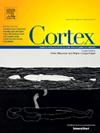Disassembling an experimental artifact in aphasia: Why phonemic errors with words and semantic errors with numbers?
IF 3.3
2区 心理学
Q1 BEHAVIORAL SCIENCES
引用次数: 0
Abstract
There is broad consensus as to the significance of speech errors in aphasia. The analysis of errors is understood to provide clear clues for clinical diagnosis, the identification of those cognitive-linguistic processes affected, and the corresponding impaired cerebral structures. However, Stimulus Type Effect on Phonological and Semantic errors (STEPS), a phenomenon in which a person with aphasia produces more phonological errors with words (e.g., “tamle” for “table”) but more semantic errors with number words (e.g., “thirteen” for “forty-two”), casts doubt on this consensus view. In this paper two studies are described, in which we explore whether STEPS is in fact a result of the lack of rigorous control over the materials compared (words versus numbers) and the evaluation conditions. Two persons, one with a reproduction conduction aphasia and the other with a repetition conduction aphasia, participated in the studies. Study 1 explored the role of memory load in the emergence of STEPS by eliciting the repetition of pairs of semantically-unrelated words. In Studies 2a and 2b, our participants were asked to produce sequences of high- and low-frequency words from one semantic category (colors), and this was compared to the performance in multi-digit number production tasks. The results showed that sequences of high-frequency colors, like multi-digit numbers, were produced mainly with semantic errors, whereas sequences of low-frequency colors showed a mixed pattern with many phonemic and semantic errors. It seems that the production of semantic errors and the absence of phonemic errors in multi-digit numbers that give rise to STEPS is an experimental artifact caused by the combination of several factors: the use of semantically-related high-frequency words, produced cyclically under high-memory-demand conditions. These findings contribute substantially to the current discussion of language production models and allow for a deeper understanding of the neurocognitive processes that underly speech errors in aphasia.
失语症的实验伪影拆解:为什么单词的音位错误和数字的语义错误?
关于言语错误在失语症中的重要性,人们有广泛的共识。错误分析可以为临床诊断、识别受影响的认知语言过程以及相应的大脑结构受损提供明确的线索。然而,刺激类型对语音和语义错误的影响(STEPS),一种失语症患者在单词上产生更多的语音错误(例如,将“table”误认为“tamle”),但在数字单词上产生更多的语义错误(例如,将“42”误认为“thirteen”)的现象,对这种共识观点提出了质疑。本文描述了两项研究,在这两项研究中,我们探讨了STEPS是否实际上是对比较材料(文字与数字)和评估条件缺乏严格控制的结果。两个人,一个是复制传导性失语症,另一个是重复传导性失语症,参加了研究。研究1通过诱导对语义不相关词汇的重复,探讨了记忆负荷在步骤产生中的作用。在研究2a和2b中,我们的参与者被要求从一个语义类别(颜色)中产生高频和低频单词序列,并将其与多位数生成任务的表现进行比较。结果表明,高频颜色序列以多位数的语义错误为主,而低频颜色序列则呈现混合模式,存在较多的音位和语义错误。似乎导致STEPS的多位数语义错误的产生和音位错误的缺失是由几个因素组合引起的实验伪影:使用与语义相关的高频词,在高内存需求条件下循环产生。这些发现对当前语言产生模型的讨论做出了重大贡献,并允许对失语症中言语错误的神经认知过程有更深入的了解。
本文章由计算机程序翻译,如有差异,请以英文原文为准。
求助全文
约1分钟内获得全文
求助全文
来源期刊

Cortex
医学-行为科学
CiteScore
7.00
自引率
5.60%
发文量
250
审稿时长
74 days
期刊介绍:
CORTEX is an international journal devoted to the study of cognition and of the relationship between the nervous system and mental processes, particularly as these are reflected in the behaviour of patients with acquired brain lesions, normal volunteers, children with typical and atypical development, and in the activation of brain regions and systems as recorded by functional neuroimaging techniques. It was founded in 1964 by Ennio De Renzi.
 求助内容:
求助内容: 应助结果提醒方式:
应助结果提醒方式:


